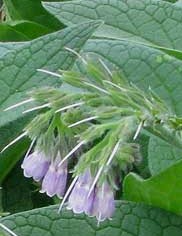 Comfrey is coarse perennial herb native to Europe and Asia where it inhabits rich moist soils. It is a member of the borgage family (Boraginaceae) along with forget-me-not, lungwort and heliotrope. The plant grows from a fleshy rhizome that is black on the outside and white within and has a stout hollow stem. The deep green leaves are hairy and up to ten inches long. The bell-shaped flowers are borne on short, one-sided, curved racemes from spring into summer and may be blue, yellow, or white. They are pendent and 1/2 inch long. Comfrey has been grown since about 400 BC by the Greeks to treat a variety of problems including wounds, bronchial infections, bleeding, and broken bones. In the 1840s comfrey was considered as a possible major food source to relieve famine but more recent research suggests that comfrey may damage the liver.
Comfrey is coarse perennial herb native to Europe and Asia where it inhabits rich moist soils. It is a member of the borgage family (Boraginaceae) along with forget-me-not, lungwort and heliotrope. The plant grows from a fleshy rhizome that is black on the outside and white within and has a stout hollow stem. The deep green leaves are hairy and up to ten inches long. The bell-shaped flowers are borne on short, one-sided, curved racemes from spring into summer and may be blue, yellow, or white. They are pendent and 1/2 inch long. Comfrey has been grown since about 400 BC by the Greeks to treat a variety of problems including wounds, bronchial infections, bleeding, and broken bones. In the 1840s comfrey was considered as a possible major food source to relieve famine but more recent research suggests that comfrey may damage the liver.
Type: Herbaceous perennial
Bloom: Blue, yellow or white bell-shaped flowers, 1/2″ long, carried on short, one-sided curved racemes from spring into summer
Size: 1-5′ H x 2-6′ W
Light: Full sun to part shade
Soil: Fertile, moist,
Care: Aggresive so may need control
Hardiness: Zones 3-9
Pests and Diseases: Powdery mildew
Propagation: Seed, root division in autumn, cuttings anytime